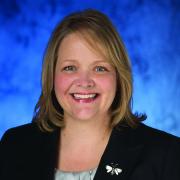Making Connections. Toward Equity

You are here
From baskets to tapestries to rugs, weaving is one of humanity’s oldest art forms. Whether they start with long grasses or silkworms, weavers bring order and utility, creating something new and beautiful.
In July 2017, NAEYC’s national governing board approved the development of a new position statement, “Advancing Equity and Diversity in Early Childhood Education.” This initiated a prescribed process of inquiry, literature review, and the convening of a working group within the guidance and leadership of the NAEYC Governing Board’s Early Learning Systems Committee. The second draft of the equity and diversity statement will be out to the field for review and comment soon. The final statement will likely be released in early 2019.
Just two months later, September 2017 marked a historic moment for NAEYC’s internal infrastructure: as a result of work that occurred over many years, there are now 52 Affiliates, all of which are brand aligned and have paid staff, an articulated governance structure, sound financial practices, and a consistent membership dues model. The Affiliate restructuring makes it much easier for early childhood educators to recognize the NAEYC/AEYC brand and for our staff to market an aligned value proposition across the country. As part of the restructuring, Affiliates were asked to complete their plans for becoming high-performing, inclusive organizations.
All the while, NAEYC has been, and still is, partnering with 14 national organizations on Power to the Profession—a national deliberation designed to create a unifying framework for the early childhood education profession. The two-year process has engaged thousands of educators through surveys, community meetings, focus groups, and deliberations within their own organizations. Among many of the issues raised throughout the process are the racial injustice that exists in the early childhood education profession and the vast and varying opinions about what it will take to bring racial equity to our field.
And of course, all of this work is taking place against the backdrop of a nation that is in deep turmoil regarding the fundamental rights of children of color, which are actively being threatened and undermined.
As I described in my May column in Young Children, “Embracing Equity: Helping All Children Reach Their Full Potential,” NAEYC is committed to being a learning organization that is self-reflective and is listening, leading, and creating room for others to lead in this space. We know this is one moment in time that is built on the history of those who have come before us and that sets the stage for those who will create our future. Organizationally, we have a history of bold and decisive moments of progress, along with missteps and inattention.
Within this context, drawing from seemingly disparate threads, NAEYC’s national governing board convened a summit this summer—“Leading and Working Toward Equity”—with the generous support of the W.K. Kellogg Foundation. The summit brought together close to 130 individuals. In addition to the Governing Board and NAEYC’s staff management team, each Affiliate and interest forum selected a representative to participate, as did the Young Professionals Advisory Committee, Affiliate Advisory Council, Commission on the Accreditation of Early Childhood Higher Education Programs, and Council for NAEYC Accreditation. Each of these entities represents NAEYC’s governance structure.
Our three-day experience was hosted by the National Equity Project, which brilliantly wove together an experience to help these leaders develop a reflective and deeper understanding in the following areas:
- What does it mean for me to lead for equity, given my identity, life experiences, and role?
- How does oppression impact the experiences of adults and children in our systems?
- What’s required to improve the quality of relationships and dialogue necessary to advance equity in our programs, schools, and systems?
- What is my role as a leader to interrupt the inequities I see?
- What are the opportunities and barriers to ensuring NAEYC’s leadership systems are equitable and diverse in service of our desire to be a high-performing, inclusive organization?
Each participant’s experience was unique and personal. Mine was one of sorrow and regret, joy and energy. Sorrow as the past and present of racial injustice were elevated and experiences were shared; regret about the moments when I did not sufficiently recognize or respond to the biases held by myself and others. Joy to be in a room with so many racial justice warriors committed to using individual agency to make progress personally, professionally, and as leaders within NAEYC; and energy in anticipation of the opportunity that is before us.
NAEYC is committed to creating room for others to lead in this space.
While we stand alongside powerful advocacy organizations in Washington, DC, and across the country, our structure as a professional association is unique. We are not merely working on behalf of the field, we are the field. From our staff to our governing boards, from Affiliates to interest forums, and from councils to commissions, NAEYC’s structure is a monumentally powerful tool to engage our membership in its entirety. But to do that successfully, we have some work of our own to do. We have to attend to our hiring practices and our election processes; how and where we hold meetings, why we hold meetings, and who leads the meetings; which policy and advocacy topics we take on; our professional development and content offerings; and our accreditation systems and leadership opportunities. And when I say we, I mean all of us. This is an open invitation to be with us—to engage, cajole, think, and experiment; to trip, get up, and continue moving forward.
The facilitators from the National Equity Project reminded us regularly that we couldn’t “strategic plan” our way through this work—that we had to create experiences to help individuals come to their own understandings and then try some things. That we would make progress, have setbacks, examine what works and what we should scrap.
We will do just that. And we will work and lead toward equity, toward weaving together our different ideas and experiences to make something new and beautiful.
Photograph: © Getty Images
Rhian Evans Allvin is the chief executive officer of NAEYC. She is responsible for guiding the strategic direction of the organization as well as overseeing daily operations. Before joining NAEYC, Evans Allvin was a guiding force in Arizona’s early childhood movement for more than 15 years, including serving as CEO of Arizona's First Things First.
